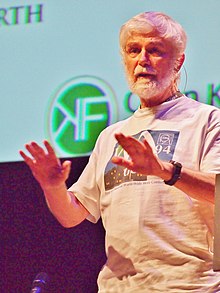Research
His research interests have involved the automated analysis of data in scientific publications, creation of virtual communities, e.g. The Virtual School of Natural Sciences in the Globewide Network Academy, and the Semantic Web. With Henry Rzepa, he has extended this to chemistry through the development of markup languages, especially Chemical Markup Language. [2] He campaigns for open data, particularly in science, and is on the advisory board of the Open Knowledge International and a co-author of the Panton Principles for Open scientific data. [3] Together with a few other chemists, he was a founder member of the Blue Obelisk movement in 2005. [4] [5] [6]
In 2002, Peter Murray-Rust and his colleagues proposed an electronic repository for unpublished chemical data called the World Wide Molecular Matrix (WWMM). In January 2011, a symposium around his career and visions was organized, called Visions of a Semantic Molecular Future. [7] [8] [9] [10] In 2011, he and Henry Rzepa were joint recipients of the Herman Skolnik Award of the American Chemical Society. [11] In 2014, he was awarded a Fellowship by the Shuttleworth Foundation to develop the automated mining of science from the literature.
In 2009 Murray-Rust coined the term "Doctor Who" model for the phenomenon exhibited by the Blue Obelisk project and other Open Science projects, where when a project leader does not have the resources to continue to lead a project (e.g. because he or she has moved to another university with other tasks), someone else will stand up to become the new leader and continue the project. [12] [13] This is a reference to the long-running British science fiction television series Doctor Who , in which the main character periodically regenerates into a different form, which is played by a different actor.
As of 2014, Murray-Rust was granted a Fellowship by Shuttleworth Foundation in relation to the ContentMine project which uses machines to liberate 100,000,000 facts from the scientific literature. [14]
This page is based on this
Wikipedia article Text is available under the
CC BY-SA 4.0 license; additional terms may apply.
Images, videos and audio are available under their respective licenses.
